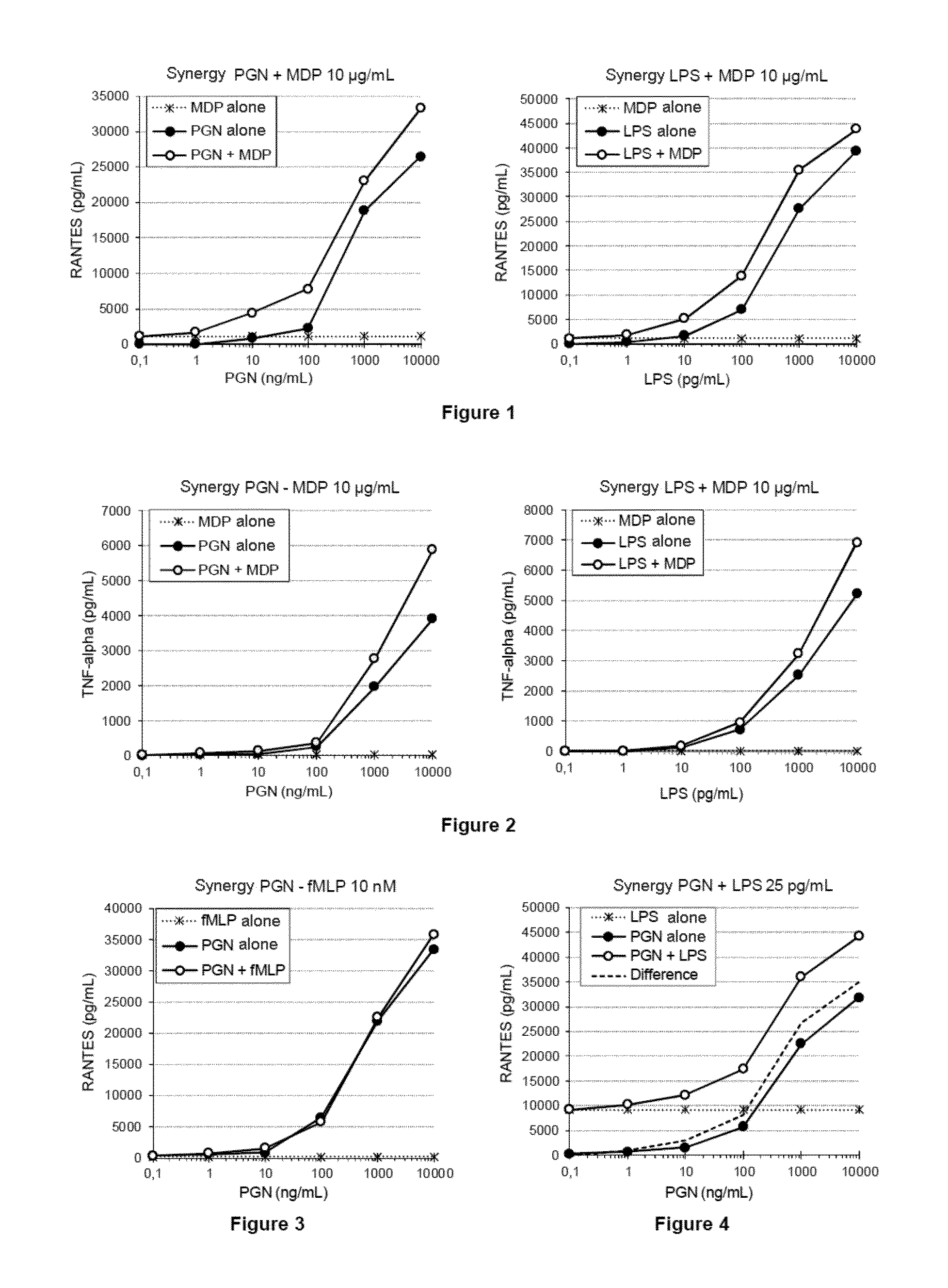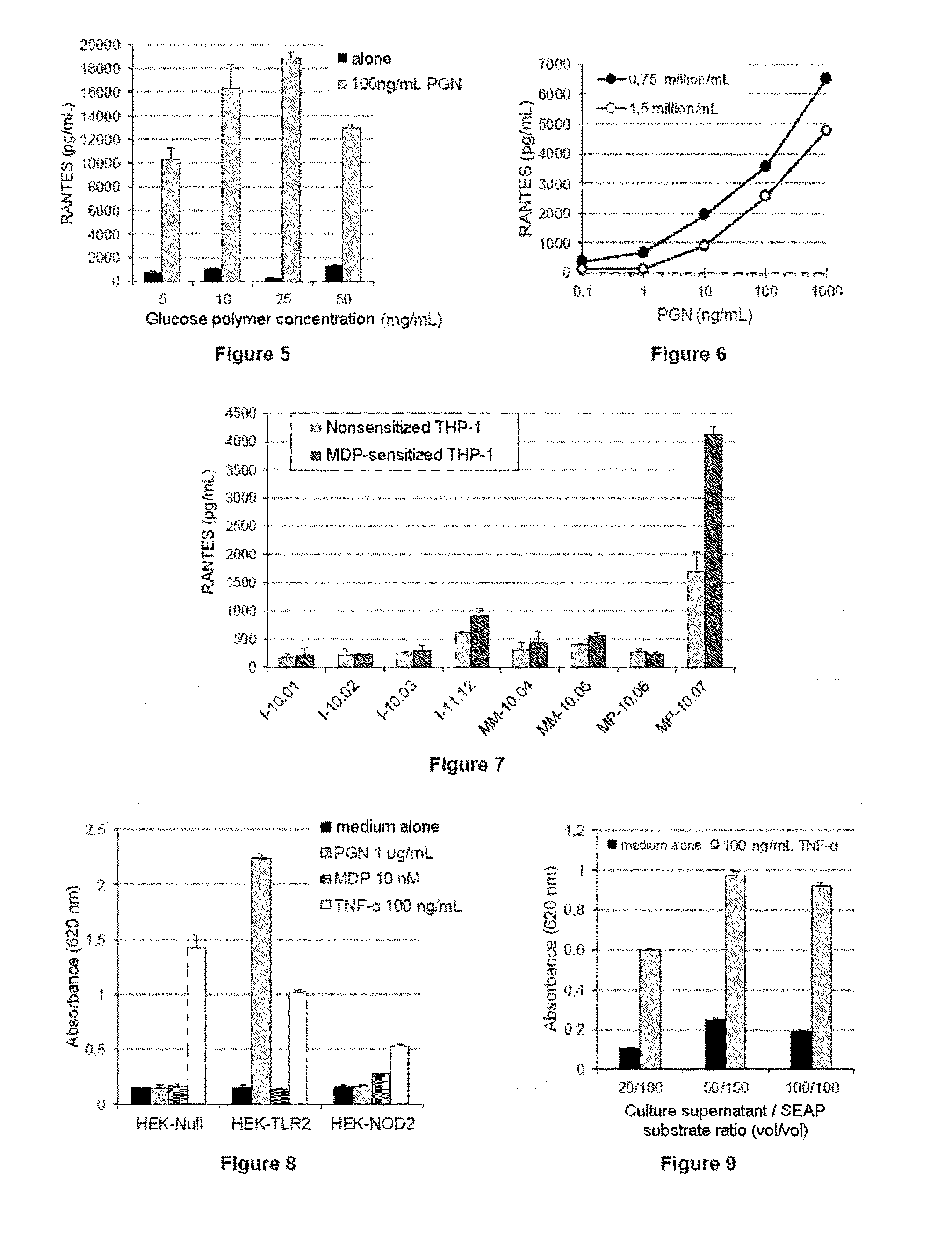Methods for detecting contaminants in solutions containing glucose polymers
a technology of glucose polymer and contaminants, which is applied in the direction of instruments, extracellular fluid disorder, metabolic disorder, etc., can solve the problems of microbial contamination of glucose polymer preparations intended for peritoneal dialysis, the risk of contamination of glucose polymer production circuits with microorganisms is to be deplored, and the method does not provide satisfaction both from the point of implementation
- Summary
- Abstract
- Description
- Claims
- Application Information
AI Technical Summary
Benefits of technology
Problems solved by technology
Method used
Image
Examples
example 1
Preparation of the Glucose Polymers for Peritoneal Dialysis
[0203]The raw material for obtaining the glucose polymers according to the invention is produced from waxy corn starch in the following way:[0204]cleaning of the corn so as to keep exclusively the whole corn grains,[0205]steeping of the corn thus cleaned, in the presence of lactic acid so as to soften the grains,[0206]wet milling, then separation of the various constituents, i.e. germ, cellulose husk, proteins and starch,[0207]cleaning of the starch in countercurrent mode with purified water so as to purify the starch both physicochemically and bacteriologically,[0208]centrifugation and drying of the starch,[0209]suspension of the starch in purified water at a final dry matter content of 40% and at a temperature of 45° C. to 50° C.,[0210]acidification of the starch suspension by addition of HCl at a pH [0211]flocculation of the proteins and of the fats at this pH,[0212]neutralization of the suspension at pH 5,[0213]filtratio...
example 2
Use of the “Sensitized” THP-1 Cell Line for Detecting Pro-Inflammatory Contaminants
[0267]Materials & Methods
[0268]The THP-1 cells (88081201, ECACC) are cultured routinely in the laboratory.
[0269]For the pro-inflammatory activation experiments, the THP-1 cells are differentiated for 3 days in the presence of phorbol ester (PMA). In particular, the cells are placed in culture in 200 μl of complete medium in the presence of 20 nM of PMA for 72 h (final cell density: 0.75×106 cells / ml).
[0270]The glucose polymer samples are prepared according to example 1.
TABLE 1Glucose polymer samplesI-I-I-I-MM-MM-MP-MP-10.0110.0210.0311.1210.0410.0510.0610.07LAL Test0.30.61.29.638.4(EU / g)Standard7552753027554613SLP Test(ng / g)SLP-HS25312393501645Test(ng / g)
[0271]The standard molecules for establishing the calibration ranges are, for the:[0272]LAL test: E. coli O55B5 LPS[0273]Standard SLP test: M. luteus PGN—Wako[0274]SLP-HS test: S. aureus PGN—Wako.
[0275]The assayed PGN values differ from one Wako test t...
example 3
Use of the HEK-Blue™ (hTLR2, hNOD2, Null2) and Raw-Blue™ (InvivoGen) Cell Lines for Detecting Contaminants
[0307]Materials & Methods
[0308]The HEK-Blue™ cell lines (InvivoGen) are lines modified by stable transfection with vectors encoding innate immunity receptors. These cells are also cotransfected with a reporter gene which produces a secreted form of alkaline phosphatase (SEAP: secreted embryonic alkaline phosphatase), the synthesis of which is under the direct control of the signaling pathway associated with the receptor(s) expressed in the same cell line.
[0309]For the experiments relating to the detection of inflammatory contaminants, four lines are used:
[0310]HEK-Blue™ hTLR2 line (HEK-TLR2): this line responds specifically to TLR2 agonists (in particular PGN and the majority of glycolipids and lipopeptides),
[0311]HEK-Blue™ hNOD2 line (HEK-NOD2): this line responds to MDP and related molecules, such as monomeric PGNs,
[0312]HEK-Blue™ Null2 line (HEK-Null): this is a control line,...
PUM
| Property | Measurement | Unit |
|---|---|---|
| concentration | aaaaa | aaaaa |
| concentration | aaaaa | aaaaa |
| concentration | aaaaa | aaaaa |
Abstract
Description
Claims
Application Information
 Login to View More
Login to View More - R&D
- Intellectual Property
- Life Sciences
- Materials
- Tech Scout
- Unparalleled Data Quality
- Higher Quality Content
- 60% Fewer Hallucinations
Browse by: Latest US Patents, China's latest patents, Technical Efficacy Thesaurus, Application Domain, Technology Topic, Popular Technical Reports.
© 2025 PatSnap. All rights reserved.Legal|Privacy policy|Modern Slavery Act Transparency Statement|Sitemap|About US| Contact US: help@patsnap.com



